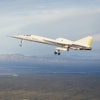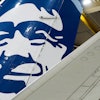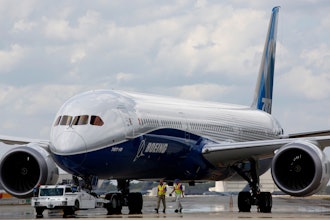A pair of aerospace veterans lead a small army of expert volunteers in the creation of a state-of-the-art single-seat aircraft.
In 2007, the UK's Civil Aviation Authority announced a new class of aircraft, known as the Single Seat De-Regulated (SSDR) class. Dr. Tony Bishop and Giotto Castelli realized that they were now free to develop a single-seat, very light aircraft without any regulations (as long as it fulfilled a certain criteria).
To jump start this newly christened class of deregulated aircraft, the UK-based Light Aircraft Association (LAA) announced a competition with two classes of design: cheap and easy-to-build, and state-of-the-art. Bishop and Castelli opted for the state-of-the-art and entered their e-Go Canard aircraft into the competition. "Canard" refers to an airframe configuration of fixed-wing aircraft in which the front surface is smaller than the rear surface.
The Bishop and Castelli brain trust first conceived e-Go (double entendre intended) with 8,000 miles between them. Castelli, currently the e-Go chief technology officer and designer, was working in Africa when news broke of SSDR. He had been sketching a Canard five-seat design at the time, which was handy given Bishop's experience designing model Canard airplanes in his teens. The two immediately realized that the Canard would best fit within the UK-specific rules, which are as follows:
- An empty weight not exceeding 115 kg.
- A maximum gross weight not exceeding 300 kg (330 kg for a seaplane).
- An empty wing loading of no more than 10 kg per square meter.
- A stall speed less than 35 knots (about 40 miles per hour).
- A single-seat design.
The e-Go won the LAA competition and the overwhelming demand that followed has kept the pair busy as they try to turn their concept into a commercial reality.
Years later, and with the help of 18 local business angels, the concept is essentially finalized, but the prototype has a ways to go. According to e-Go CEO Bishop, the prototype is only 70 percent complete, and the team is currently working through the final few large components. However difficult it may be to pinpoint an exact end-date, Bishop plans to have the prototype completed by the end of May 2012.
"We're trying to put as much effort into designing an innovative business as we have with our innovative product, because the two need to go hand-in-hand in order to successfully penetrate the live aircraft market," Bishop says about the development timeline. "In retrospect, and this is post-rationalizing things somewhat, we were doing a huge amount of technology development [in the beginning] because we were using composites and firm materials in ways that have never been [executed] before."
Composite structures typically incorporate a number of material layers, but the e-Go wing and wing spars, for example, are made out of a single-layer of carbon fiber that is 0.2 mm thick and supported with various grades of foam. In order to develop and deliver a complete product, Castelli has been charged with developing the ultra light aircraft and stabilizing them, while Bishop has been investigating "fairly cheap" ways to manufacture. Fairly cheap is a relative term in such a wide-ranging aerospace industry (the Boeing 787-9 is listed around $227.8 million), but the e-Go will be made available for around £50,000 (about $78,000), according to Bishop.
Prototype Process
The e-Go will weigh 115 kg upon completion and be suitable for a pilot who weighs up to 110 kg. The weight estimate remained spot on throughout the process as even the initial sketch called for a 115 kg aircraft and has yet to deviate from that mark, a landmark that is not lost on Bishop. "It's very unusual in any aircraft program to maintain weight," he says. "Whether it's at our end of the scale or at Boeing or Airbus, the aircraft nearly always come in overweight."
Bishop attributes maintaining weight to two key details: the initial system concept design in a 3D CAD system and deregulation. According to Bishop, modeling the system in Solidworks 3D CAD provided acceptable weight estimates that have been monitored meticulously throughout the process. However, deregulation remains one of the most powerful developments that continues to improve time-to-market and control costs.
"Because we're deregulated, we will redesign and remake the same components two or three times within a few days," says Bishop. "That is incredibly valuable in any rapid prototyping situation. It's also something that's very hard to do in a regulated environment where every modification has to be approved." In developing a radically new product, the e-Go design team needed such fluidity to quickly meet challenges and find solutions. The success of the project hinged on the ability to remain flexible while continuing a breakneck pace.
Data Analysis
Bishop and Castelli have deployed a full range of modern testing technologies, including finite element analysis (FEA), computational fluid dynamics (CFD), wind tunnel tests and structural tests, but not without relying on a loyal community of volunteers, companies, and universities. e-Go only has four full-time employees, but up to 6 volunteers are on site on an average day.
"One thing that is unusual about this project is that we've built up a very strong partner community that has been working with us to get the technology right," says Bishop. "We have people, particularly on the FEA and CFD, who are professionals in these areas doing a lot of work for us in their spare time."
Lola Cars, a UK-based developer of award-winning rally cars, is one sponsor that has offered CFD work, particularly around the engine installation. The e-Go includes a small, high-powered Rotron Wankel engine that is tightly located at the back of the aircraft, and fundamentally difficult to keep cool.
Lola provided a number of studies for the overall aircraft airflow, but it also helped to make sure that the airflow through the engine installation works properly. The Rotron Wankel is a water-cooled engine so it was a question of what the smallest acceptable radiator size would be and where to install it.
"We had interesting problems such as how to keep the engine cool when the aircraft is grounded on a very hot day and unable to get any airflow through that cooling system," says Bishop. "We have various design techniques that we've used around that problem."
While unsure of which method to deploy, Lola and e-Go arrived at a few alternatives. Clearly, a fan can be placed behind the radiators if need be, but the design team has also discussed the installation of a major flap above the engine. The flap, or louvered grill, would simply open when the aircraft is static to dump hot air with natural convection. The louvers would close automatically during flight to streamline the design and improve the flow through the engine bay. These are basic techniques, but it's important to make sure that everything is located in the right place in order to achieve a successful new aircraft.
Component Count
The e-Go crew worked diligently to keep the component count down. According to Bishop, if any piece of the airframe didn't perform at least two or three jobs, the staff considered it redundant. The total part count (counting the engine as one part) is below 400 for the entire aircraft. To Bishop, that translates to: simpler and cheaper to make, and low weight.
"Every light aircraft we have seen is far more complex than it needs to be. We concentrated on component count," says Bishop. The mission critical components that have hoarded much of e-Go's energy include the engine and the avionics.
Wankel engines have become quite popular in Europe because of their vibration-free design that Bishop calls "remarkably simple." According to Bishop, a major overhaul takes little more than an hour. As he describes the process, "Undo six bolts; replace a bearing and some seals; and put it back together. It's basically a four-stroke engine without the reciprocating cylinders. It's fundamentally a good design and half the weight of a four-stroke engine."
Materials
The primary structural material is pre-impregnated, tooled carbon with unidirectional carbon for areas that require additional strength. Glass fiber is used for areas that don't require much strength to help keep the weight low.
Around the fuselage, most of the structure is based on a "foam sandwich". Typically, it's one thin layer of the aforementioned carbon fiber, 3 mm of foam, and then another layer of carbon. Because the team is using pre-impregnated material and very thin structures, it does experience more resin leaching into the foam. As a result, e-Go came up with its own specification with a higher resin content.
"Most people use honeycomb materials, but we prefer foam, because potential water damage on ultra-light structures is hard to inspect," says Bishop. "We used a closed-cell foam, which is safer in that respect."
With the honeycomb materials that e-Go considered, any damage to the structure could allow water to seep into the structure and damage the honeycomb. With closed-cell foam, water damage won't spread internally and the structure will maintain its integrity.
The wing design is more unconventional. e-Go uses a lot of polystyrene foam to stabilize the structure, and then shapes the foam with a CNC hotwire cutter. If you imagine tapered airfoil sections, this process helps hollow them out in a way that lowers overall weight, yet creates sufficient stabilization and the ability to handle the aerodynamic loads.
The current specifications allow the e-Go to cruise at 120 knots (35 miles per hour) with a total distance capability of 300 miles. After all, if you take off in the UK, you won't find many places to land after 250 miles.
"It's amazing how light you can make composite products if you try," Bishop boasts. "Those who have seen us produce a complete, 16-kilo wing, which takes more than a ton of load, are astonished at what we've done. In the end, it's all fairly straight forward science and engineering, but the whole aircraft is half of the weight of anything anyone else has attempted to do in this market. If you really push yourself, I've found that it's amazing what you can come up with."























